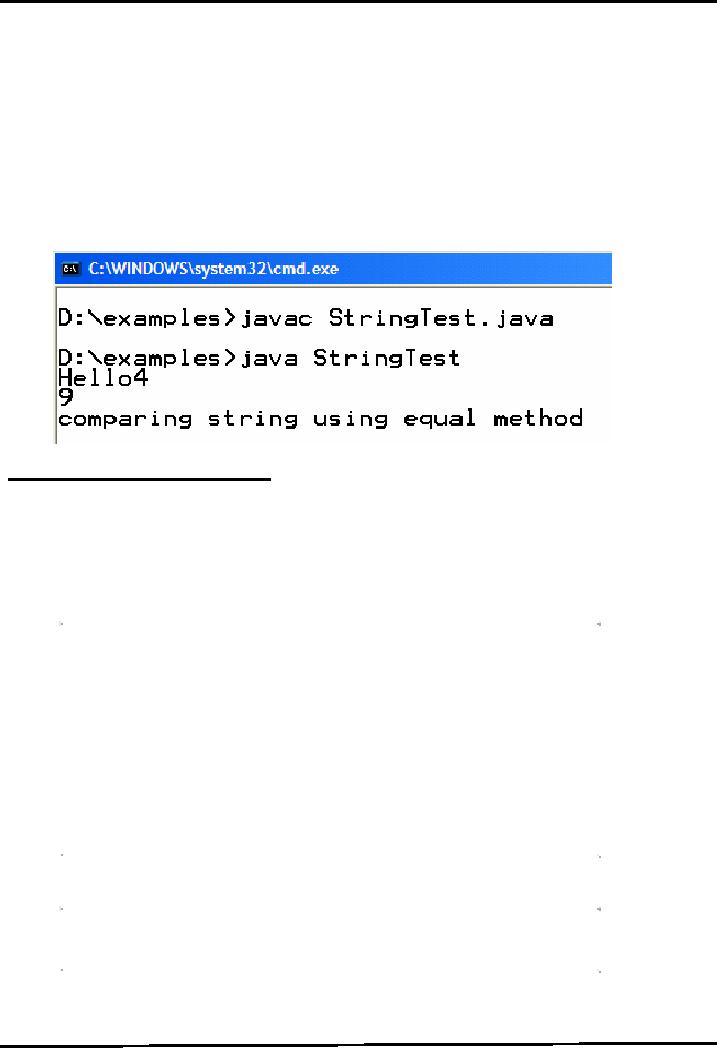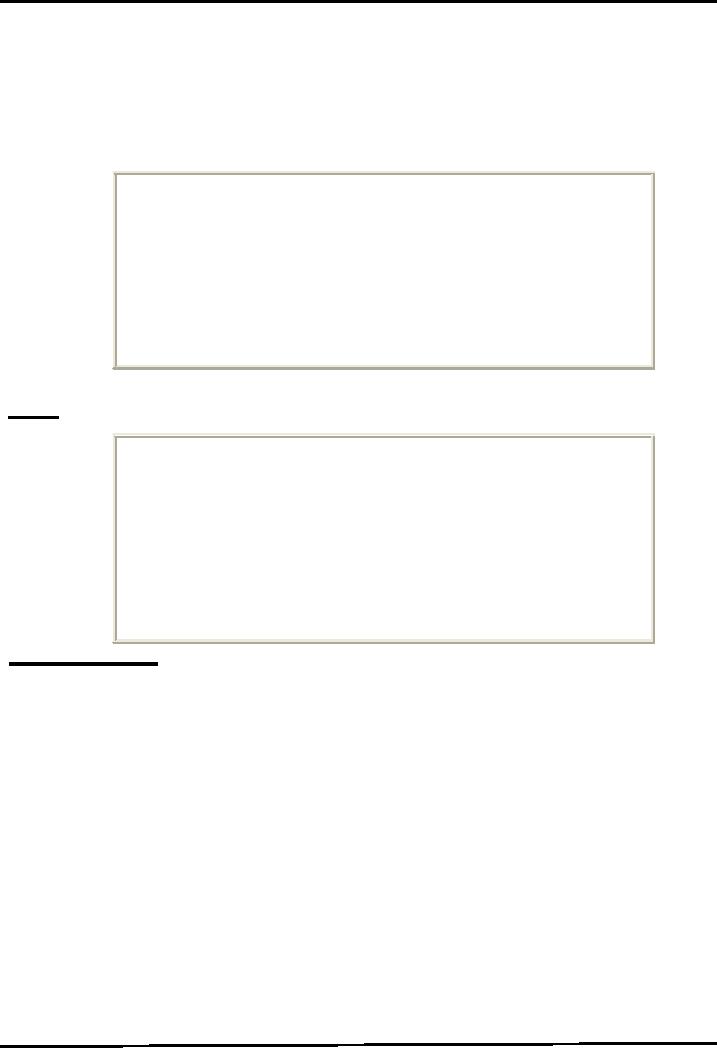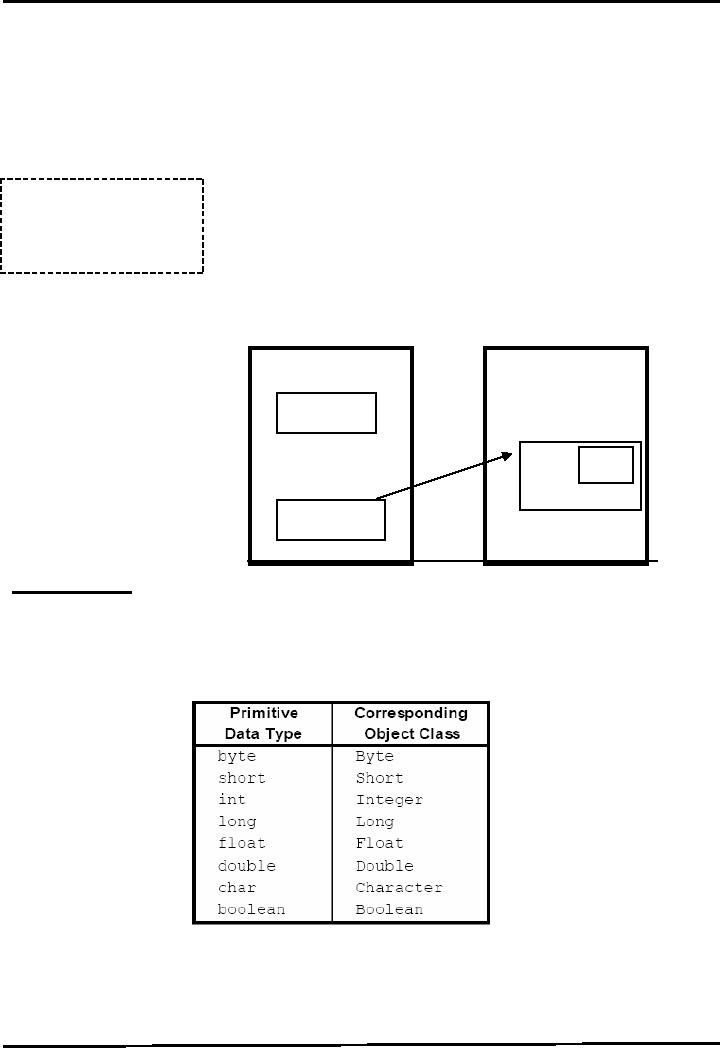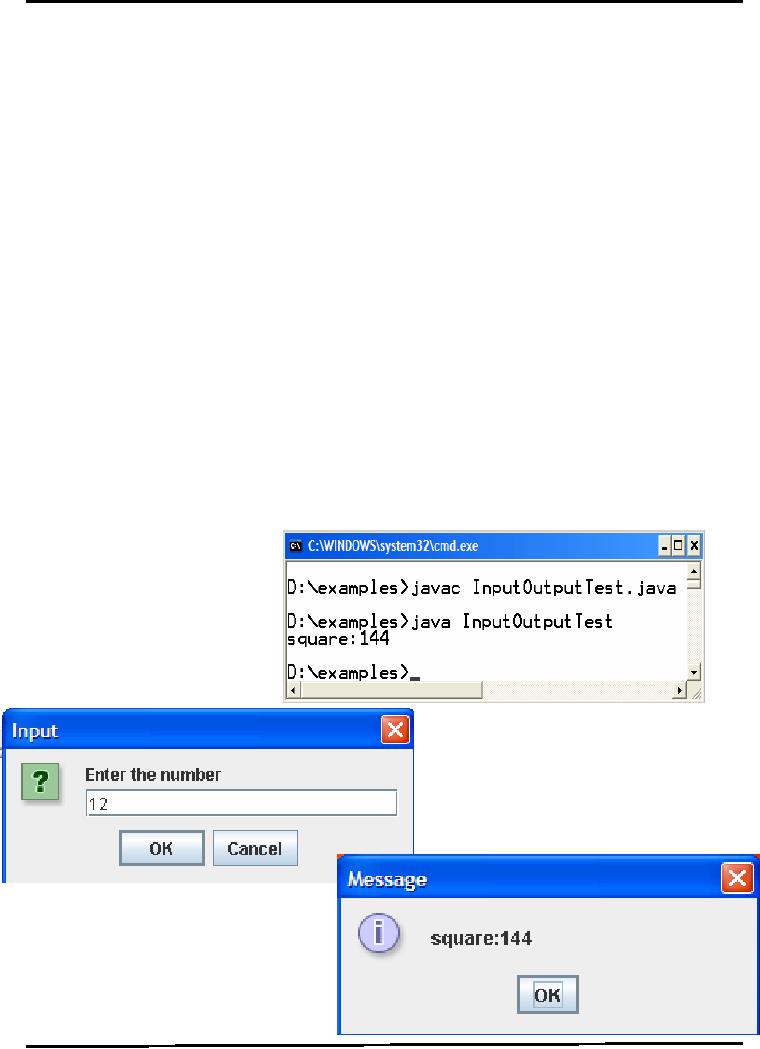 |
Learning Basics of JAVA |
| << Java Virtual Machine & Runtime Environment |
| JAVA: Object Oriented Programming >> |

Web
Design & Development CS506
VU
Lesson
3
Learning
Basics
Strings
A string
is
commonly considered to be a sequence of
characters stored in memory
and accessible as a
unit.
Strings in java are represented as
objects.
String
Concatenation
"+"
operator is used to concatenate
strings
System.out.pritln("Hello" + "World")
will print Hello World on
console
String
concatenated with any other
data type such as int
will also convert that
datatype to
String
and the result will be a concatenated
String displayed on console.
For example,
int i
= 4;
int j
= 5;
System.out.println
("Hello" + i)
will
print Hello
4 on
screen
However
System,.out..println(
i+j) ;
will
print 9 on the console because
both i and j are of type
int.
Comparing
Strings
For
comparing Strings never use
== operator, use equals
method of
String class.
==
operator compares addresses
(shallow comparison) while equals
compares values (deep
comparison)
E.g
string1.equals(string2)
Example
Code: String concatenation and
comparison
public
class StringTest {
public
static void main(String[]
args) {
int i
= 4;
int j
= 5;
System.out.println("Hello"
+ i); // will print
Hello4
System.out.println(i
+ j); // will print 9
String
s1 = new String ("pakistan");
String
s2 = "pakistan";
if
(s1 == s2) {
16

Web
Design & Development CS506
VU
System.out.println("comparing
string using == operator");
}
if
(s1.equals( s2) ) {
System.out.println("comparing
string using equal
method");
}
}
}
On
execution of the above program, following
output will produce
Taking
in Command Line
Arguments
In
Java, the program can be
written to accept command-line-arguments.
Example
Code: command-line arguments
/*
This Java application illustrates the
use of Java command-line
arguments.
*/
public
class CmdLineArgsApp {
public
static void main(String[] args){
//main method
System.out.println("First
argument " + args[0]);
System.out.println("Second
argument " + args[1]);
}//end
main
}//End
class.
To
execute this program, we pass
two arguments as shown
below:
public
void someMethod( ) {
int
x; //local variable
System.out.println(x);
// compile time error
�
These
parameters should be separated by
space. .
�
The
parameters that we pass from
the command line are stored
as Strings inside the "args"
17

Web
Design & Development CS506
VU
array.
You can see that the
type of "args" array is
String.
Example
Code: Passing any number of
arguments
In
java, array knows their
size by using the length
property. By using, length
property we can
determine
how
many arguments were passed. The
following code example can
accept any number of
arguments
*
This Java application illustrates the
use of Java
command-line
arguments. */
public
class AnyArgsApp {
public
static void main(String[] args){
//main method
for(int
i=0; i < args.length;
i++)
System.out.println("Argument:"
+ i + "value" +args[i]);
}//end
main
}//End
class.
Output
C:\java
AnyArgsApp i can pass any
number of arguments
Argument:0
value i Argument:1
value
can
Argument:2 value
pass
Argument:3
value any
Argument:4
value
number Argument:5 value
of
Argument:6
value arguments
Primitives vs
Objects
�
Everything
in Java is an "Object", as every
class by default inherits
from class
"Object"
, except a few primitive data types,
which are there for
efficiency reasons.
�
Primitive
Data Types
Primitive
Data types of java
boolean,
byte
1
byte
char,
short
2
bytes
int,
float
4
bytes
long,
double
8
bytes
�
Primitive
data types are generally
used for local variables,
parameters and
instance
variables
(properties of an object)
�
Primitive
datatypes are located on the
stack and we can only access
their value, while
objects
are
located on heap and we have a reference to
these objects
�
Also
primitive data types are
always passed by value while
objects are always passed
by
reference in
java. There is no C++ like
methods
18

Web
Design & Development CS506
VU
void
someMethod(int &a, int & b ) //
not available in java
Stack
vs. Heap
Stack and
heap are two important
memory areas. Primitives are
created on the stack while
objects
are
created on heap. This will
be further clarified by looking at the
following diagram that
is
taken
from Java Lab
Course.
int
num = 5;
Student
s = new Student();
Stack
Heap
num
5
0F59
name
ali
0F59
Wrapper
Classes
Each
primitive data type has a
corresponding object (wrapper class).
These wrapper classes
provides
additional functionality (conversion,
size checking etc.), which a primitive
data type cannot
provide.
Wrapper
Use
You
can create an object of Wrapper
class using a String or a
primitive data type
�
Integer
num = new Integer(4);
or
�
Integer
num = new
Integer("4");
19

Web
Design & Development CS506
VU
Note:
num
is an object over here not a
primitive data type
You
can get a primitive data
type from a Wrapper using the
corresponding value function
�
int
primNum = num.intValue();
Converting
Strings to Numeric Primitive
Data Types
To
convert a string containing
digits to a primitive data
type, wrapper classes can
help. parseXxx
method
can be used to convert a
String to the corresponding primitive
data type.
String
value = "532";
int d
= Integer.parseInt(value);
String
value = "3.14e6";
double
d = Double.parseDouble(value);
The
following table summarizes the
parser methods available to a
java programmer.
Data
Type
Convert
String using either
...
byte
Byte.parseByte(string
)
new
Byte(string
).byteValue()
short
Short.parseShort(string
)
new
Short(string
).shortValue()
int
Integer.parseInteger(string
)
new
Integer(string
).intValue()
long
Long.parseLong(string
)
new
Long(string
).longValue()
float
Float.parseFloat(string
)
new
Float(string
).floatValue()
double
Double.parseDouble(string
)
new
Double(string
).doubleValue()
Example
Code: Taking Input /
Output
So
far, we learned how to print
something on console. Now the time
has come to learn how to
print
on the
GUI. Taking input from
console is not as straightforward as in
C++. Initially we'll study
how to
take
input through GUI (by using
JOPtionPane class).
The
following program will take
input (a number) through GUI and
prints its square on the console
as
well
on GUI.
1.
import javax.swing.*;
2.
public class InputOutputTest
{
3.
public static void
main(String[] args) {
4.
//takes input through
GUI
5.
String input =
JOptionPane.showInputDialog("Enter
number");
6.
int number =
Integer.parseInt(input);
7.
int square = number * number;
20

Web
Design & Development CS506
VU
8.
//Display square on
console
9.
System.out.println("square:" +
square);
10.
//Display square on GUI
11.
JOptionPane.showMessageDialog(null, "square:"+
square);
12.
System.exit(0);
13.
}
14.
}
On
line 1, swing package was
imported because it contains the JOptionPane
class
that will be used
for
taking input from GUI and
displaying output to GUI. It is
similar to header classes of
C++.
On
line 5, showInputDialog method is called
of JOptionPane class by passing string
argument that
will
be displayed on GUI (dialog box).
This method always returns back a String
regardless of whatever
you
entered (int, float, double, char) in the
input filed.
Our
task is to print square of a
number on console, so we first
convert a string into a number
by
calling
parseInt method of Integer wrapper
class. This is what we done
on line number 6.
Line
11 will display square on GUI
(dialog box) by using
showMessageDialog method of JOptionPane
class.
The first argument passed to
this method is null and the second
argument must be a String.
Here
we use string concatenation.
Line
12 is needed to return the control back
to command prompt whenever we
use
JoptionPane
class.
Compile
& Execute
21

Web
Design & Development CS506
VU
Selection
& Control Structure
The
if-else and switch selection
structures are exactly
similar to we have in C++. All
relational
operators
that we use in C++ to
perform comparisons are also
available in java with same
behavior.
Likewise
for, while and do-while
control structures are alike
to C++.
Reference:
1-
Java tutorial:
http://www.dickbaldwin.com/java
2-
Example code, their
explanations and corresponding figures
for this handout are
taken from the book
JAVA A
Lab Course by Umair Javed.
This material is available
just for the use of VU
students of the
course
Web Design and Development and
not for any other commercial
purpose without the consent
of
author.
22
Table of Contents:
- JAVA FEATURES
- Java Virtual Machine & Runtime Environment
- Learning Basics of JAVA
- JAVA: Object Oriented Programming
- JAVA: Inheritance
- JAVA: Collections
- JAVA: Intro to Exceptions
- JAVA: Streams
- JAVA: Modification of Address Book Code
- JAVA: Graphical User Interfaces
- JAVA: Event Handling
- JAVA: More Examples of Handling Events
- JAVA: Problem in Last Code Example
- Java Database Connectivity
- JAVA: More on JDBC
- JAVA: Result Set
- JAVA: Meta Data
- Java Graphics
- JAVA: How to Animate
- JAVA Applets
- JAVA: Socket Programming
- JAVA: Serialization
- JAVA: Multithreading 1
- JAVA: Multithreading 2
- JAVA Web Application Development
- Java Servlets
- JAVA: Creating a Simple Web Application in Tomcat
- JAVA: Servlets Lifecycle
- JAVA: More on Servlets
- JAVA: Dispatching Requests
- JAVA: Session Tracking 1
- JAVA: Session Tracking 2
- JAVA: AddressBook Case Study Using Sevlets
- Java Server Pages 1
- JavaServer Pages 2
- Java Server Pages 3
- JAVA: JSP Action Elements and Scope
- JAVA: JSP Custom Tags
- JAVA: MVC + Case Study
- JAVA: MVC Model 2 Architecture
- JAVA: Layers and Tiers
- JAVA: Expression Language
- JAVA: JavaServer Pages Standard Tag Library (JSTL)
- JAVA: Client Side Validation & JavaServer Faces (JSF)
- JAVA: JavaServer Faces